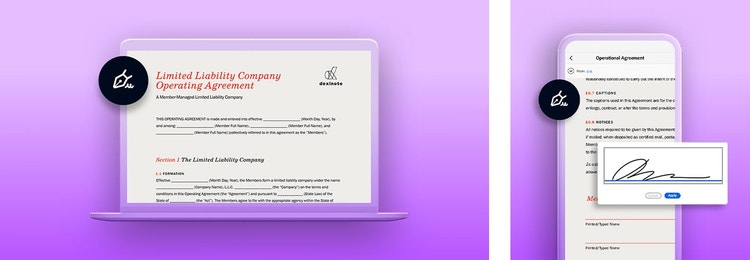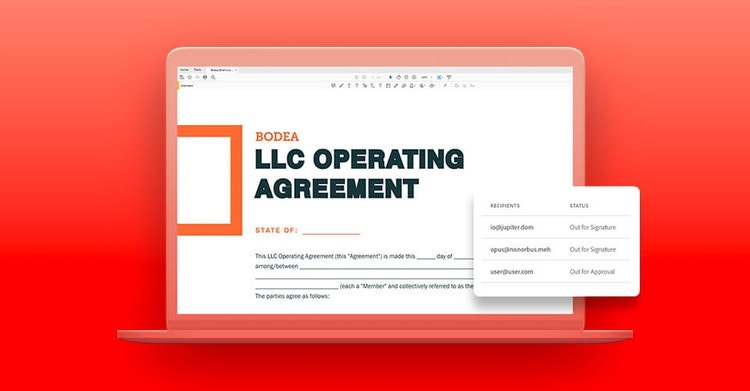Adobe Acrobat Sign
Set up your business with an operating agreement.
An LLC operating agreement creates a management structure for partners and business owners. Learn what to put into an operating agreement and why every LLC needs one.

What is an operating agreement?
An operating agreement is a document used by limited liability companies (LLCs) to define roles, responsibilities, and liabilities for the business. This includes basic information for the LLC, such as the business address and contact information for each partner. It also outlines how much each partner owns, what happens if a new partner joins the organization, and what steps to take if a partner wants to exit the LLC. Operating agreements also sketch out how the LLC will be managed at a high level. They provide liability protection and include specific needs for the LLC.

How to write an operating agreement.
Operating agreements usually include:
- Business name
- Information about the articles of organization
- Duration of the LLC
- Business address and other relevant contact information
- Name and address of the registered agent
- Purpose of the business
- Name of the initial members
- Amount of initial capital contribution of each member
- Ownership percentage of each member
- Ownership interest of each member
- A framework for accepting new members, usually through capital contributions
- How members receive profits and losses each year
- How taxes are distributed and allocated
- A plan for how the LLC will be managed, including how to handle decision-making and voting rights of the partners
- How to leave the LLC
- A way to end the LLC, if necessary
- A liability clause

Why you need an operating agreement.
Operating agreements allow the partners of an LLC to run their business the way they want rather than to adhere to a state’s preexisting framework for running an LLC. Operating agreements ensure that all parties understand their roles and responsibilities, know what to do in given situations, and always know how much of the business they own.
Operating agreements are also useful if there’s a dispute among the partners. They often provide a framework for how to resolve a disagreement. Whether there are disputes or not, operating agreements help businesses avoid confusion about who is responsible for what and describe what steps to take in certain situations.
If you don’t have an operating agreement for your LLC, your state’s default rules will govern the roles and responsibilities in your company. In the event of a dispute or other issue, it is those laws, rather than your own agreed-upon framework, that will govern how partners in your LLC approach their roles.
State laws and operating agreements.
When you create an operating agreement, familiarize yourself with your state’s default operating laws, how your state handles partner disputes, and any other relevant compliance issues you may face. Check with your state’s business division to see if you are meeting all legal requirements. Business divisions are usually, but not always, part of the Secretary of State’s office.
U.S. states generally don’t require you to file an operating agreement with the state, but LLCs do need documentation, either their own agreement or a state’s preexisting framework, that outlines rights and responsibilities. Every business entity, even one as small as a sole proprietorship, needs protections from risks like personal liability and a roadmap for events like buyouts.
If you are uncertain about your legal rights and responsibilities when you create an operating agreement, consult a business attorney who specializes in your local laws.

Make better operating agreements with e-documents.
Just like any other contract or agreement, operating agreements require written assent from the participants. Operating agreements also change over time as members’ ownership or interest shifts over the course of the business’s lifetime.
With electronic signatures, partners can gain approval from members of an LLC quickly and efficiently. Electronic signatures are legally binding in all American states and territories, as well as most other countries across the globe.
Manage and amend existing agreements with Adobe Acrobat Pro.
Learn how to update, amend, and keep track of agreements while tracking transaction-specific information.
Annotate and personalize transactions.
Sometimes transactions need additional context. Find out how to add a note with a signature and manage your remarks on an agreement.